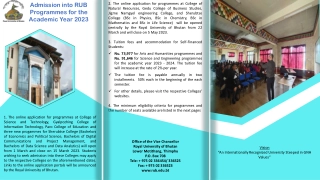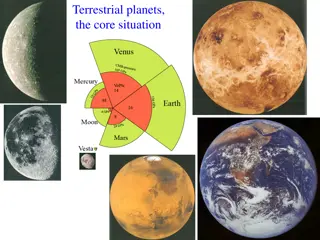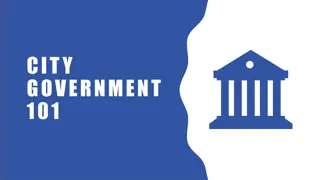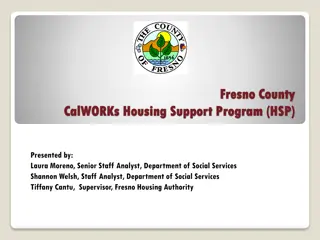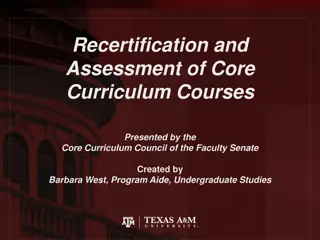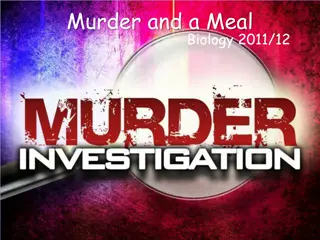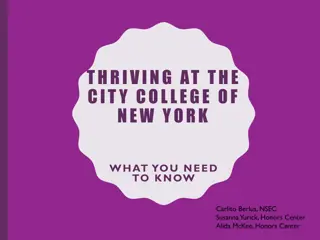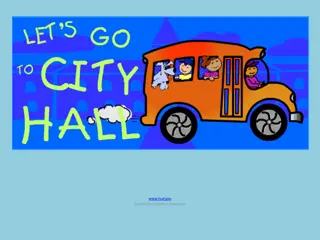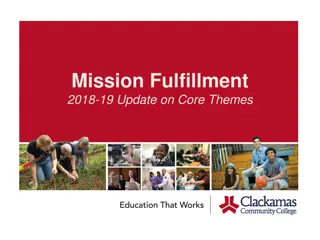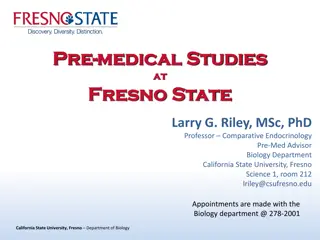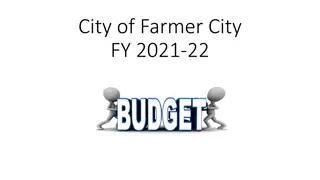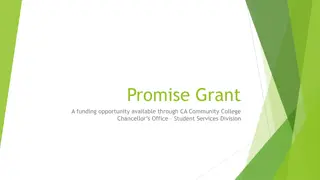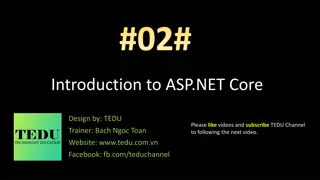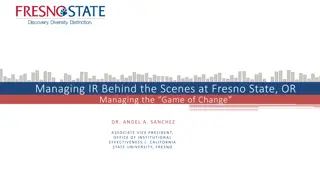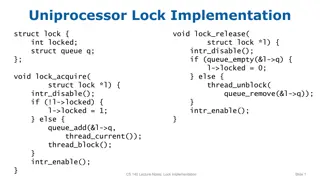Strategies for Improving Core 9 at Fresno City College
Various strategies are being implemented at Fresno City College to enhance Core 9 indicators through evidence-based solutions and data-driven communication. Initiatives include engaging dialogue, conducting surveys, and developing communication avenues to support the implementation of solutions aimed at improving college outcomes.
Download Presentation

Please find below an Image/Link to download the presentation.
The content on the website is provided AS IS for your information and personal use only. It may not be sold, licensed, or shared on other websites without obtaining consent from the author. Download presentation by click this link. If you encounter any issues during the download, it is possible that the publisher has removed the file from their server.
E N D
Presentation Transcript
An Open Forum with Dr. Goldsmith 11:30am 1:00pm August 23 2018 OAB 251 1
FCC Current Enrollment Fall 2018 (as of today) Current FTES % of Target Target Fresno City College
FCC designated smoking areas on campus effective 1/1/2015 Fresno City College
Changes coming New laws-Smoking and the use of electronic cigarettes would be banned on campuses of the California State University and California Community Colleges systems beginning in 2018 under legislation approved by the state Assembly. In May 2018, the Board of Governors approved a resolution to make all 114 community colleges 100% smoke and tobacco-free. Currently 100% smoke-free campuses: all UC/CSU. 37% of 2-year colleges. Fresno City College
Institutional Set Standards Core 9 QFE Goals to Improve Core 9 Results: Goal 1: Engage the College in dialogue about Core 9 Indicators and possible evidence-based solutions to improve results. Goal 2: Select specific, evidence- based solutions that support achievement of Core 9 Indicators Goal 3: Create a Core 9 Achievement plan to implement identified solutions Fresno City College
Strategies to Improve Core 9 SPC, Institutional Research and Effectiveness (IRE) Committee and Student Equity, and Success (SES) committee will collaborate to develop opportunities for data driven conversations and communication Develop and conduct a constituency-based survey to determine support for possible evidence-based solutions SES will examine data, plans, initiatives, surveys, including IRE recommendations, to select specific evidence based solutions that are broadly supported by constituent groups Fresno City College
Strategies to Improve Core 9 Develop multiple avenues for communication of Core 9 solutions Create professional development opportunities, including Flex Day activities, that support implementation of solutions Create a plan that clearly identifies broad constituent supported solutions, outcomes, resources, responsibilities, and assessment Implement plan and assess results Fresno City College
Progress of Achieving Core 9 7 of 9 measures have new data available. 4 measures exceeded the targets. 5 measures were improved in 2017-18. One measure unchanged. Fresno City College
Core Measure #2: Course Success Rate Core Measure #1: Course Retention Rate 2017-18: 91.0% MET TARGET No change over last year 2017-18: 69.2% +0.3% over last year Target: 91.0% Target: 71.0% Baseline: 65.3% Baseline: 88.6% Note: The percentage of students retained out of the total enrolled (percent of A, B, C, D, F, P, NP, or I. Only excludes W s). Fall Term. Note: The percentage of students successful (with a grade of A, B, C, P) in courses out of the total enrolled. Fall Term. Fresno City College
Core Measure #4: 6-Year Completion Rate (Scorecard) Core Measure #3: DE Course Success Rate EXCEEDED TARGET 2017-18: 68.8% +4.7% over last year 2017-18: 41.4% -1.0% over last year Target: 66.0% Baseline: 40.2% Target: 47.0% Baseline: 59.3% Note: The percentage of students successful (with a grade of A, B, C, P) in online and hybrid courses out of the total enrolled. Fall Term. Note: Percentage of degree, certificate, and/or transfer-seeking students starting first time and tracked for six years who completed a degree, certificate, or transfer-related outcomes. Fresno City College
Core Measure #5: Basic Skills Ed Progress (Scorecard) Math EMLS 2017-18: 36.4% +4.3% over last year English 2017-18: 37.2% +1.4% over last year EXCEEDED TARGET EXCEEDED TARGET EXCEEDED TARGET 2017-18: 36.9% +1.2% over last year Target: 34.0% Target: 35.0% Target: 31.0% Baseline: 27.0% Baseline: 28.4% Baseline: 30.8% Note: Percentage of credit students tracked for six years who first enrolled in a course below transfer level in English, mathematics, and/or EMLS and completed a college-level course in the same discipline. Fresno City College
Core Measure #6-1: Transfer Level English (Scorecard) Transfer English 2nd Year Transfer English 1st Year 2017-18: 29.1% +4.6% over last year 2017-18: 44.1% +3.9% over last year Target: 56.0% Target: 38.0% Baseline: 32.3% Baseline: 16.7% Note: The percentage of first-time students in a year who complete 6 units and attempt and Math or English in their first year who complete a transfer-level course in English in their first or second year. Fresno City College
Core Measure #6-2: Transfer Level Math (Scorecard) Transfer Math 2nd Year Transfer Math 1st Year 2017-18: 23.9% +3.6% over last year 2017-18: 13.3% +2.6% over last year Target: 17.0% Baseline: 16.5% Baseline: 9.3% Target: 29.0% Note: The percentage of first-time students in a year who complete 6 units and attempt and Math or English in their first year who complete a transfer-level course in Math in their first or second year. Fresno City College
Core Measure #9: Number of Degrees/Certificates Awarded Target: 2,100 2017-18: 3,552 +1,582 over last year Baseline: 1,463 EXCEEDED TARGET Fresno City College Note: Only includes degrees or certificates approved by state Chancellor s Office.
Important Science Planning Events New Science Building August 24 TBA 2-4 pm New Science Building Sept 7 TBA Biology Faculty 11am-12 pm Chemistry 1:30 2:30 pm Schematic Design Team 3:30- 4:30 New Science Building Sept 28 TBA 1-3 pm New Science Building Oct 19 TBA 1-3 pm Fresno City College
Important West Fresno Planning Events West Fresno - August 24 at OAB 126 12-1:30 pm West Fresno/CTC Open Forum Aug 30 OAB 251 First Session - 3:30 5:00 pm Repeat Session 5:30 7:00 pm West Fresno/CTC Open Forum Sept 13 Edison High School - 5:30 7:00 pm Design Charrette Sept 28 OAB 2519 AM noon Repeat Session TBA Fresno City College
Campus-wide Events Building Diversity Workshop - Sept 5 Habitat for Humanity Breakfast Sept 6 Relay for Life Sept 8-9 9/11 Ceremony Faculty Equity Lab Sept 21 Madera College Groundbreaking Oct 2 Toasting the Arts Oct 20 Fresno City College
The Atlantic: Fresnos Mason-Dixon Line More than 50 years after redlining was outlawed, the legacy of discrimination can still be seen in California s poorest large city. - By Reis Thebault, August 20, 2018 (a local politics reporter at the Washington Post) Fresno City College
In 1936, the Fresno Home Owners' Loan Corporation drew color-coded maps to determine who would get the credit necessary to buy houses. White neighborhoods were shaded green, and white buyers in these areas were generally approved for loans. Neighborhoods with large minority populations were shaded red, denied mortgages, and labeled undesirable. The Home Owners' Loan Corporation used this redlining map to preserve segregation in Fresno. Source of Picture: Courtesy of T-RACES, University of Maryland Fresno City College
History of Fresno Segregation Segregation is older than the city itself, dating to its post- Gold Rush-ear founding. Segregation that began with Chinese immigrants evolved over time to target Hispanic and, most explicitly and acutely, black residents. In the 1800s, Fresno developed around a railroad station. The poorest residents, and residents who were not white, were forced to live, literally, on the other side of the tracks. At an 1873 town meeting, Fresno s white residents agreed not to rent, sell or lease any land east of the railroad tracks, where they and their families lived, to Chinese immigrants many of whom built the very tracks that cut them off from the rest of Fresno. Fresno City College
History of Fresno Segregation Over the next 25 years, the city grew quickly and attracted Mexican, Japanese, Armenian, and Italian immigrants, who were also forced to live in southwest Fresno. In 1918, Fresno s first-ever general plan formalized existing residential segregation by reserving the southern quadrants of the city for polluting, foul-smelling industrial businesses, and affordable housing. The zoning rules established a pattern that persists today: Fresno s poorest and most vulnerable residents were consigned to the same neighborhoods as the city s dirtiest factories. Fresno City College
History of Fresno Segregation These policies, and the redlining that cemented them, made it virtually impossible for black Americans, who came to Fresno in greater numbers after World War II, to move in anywhere but the city s southwest. By the 1950s, nearly 100 percent of black Fresnans lived on the west side. The construction of Highway 99 in the 1950s - created another physical barrier between the west side and the rest of Fresno. It was referred as Fresno s Berlin Wall by a member of the Fresno County Board of Supervisors. Fresno City College
History of Fresno Segregation The city s schools were as divided as its neighborhoods. Edison High School had a population that was 99.6% minority students. School administrators were assigning black and Hispanic students to mentally retarded classes. In 1973, Fresno Unified School District was cited in violation of Civil Rights Act for heavily segregated schools. Fresno City College
History of Fresno Segregation In the decades that followed, city plans and zoning ordinances kept the southwest isolated. Fresno s leaders concentrated the city s wealth and development farther north, catering to its affluent white neighborhoods. Today Shaw Avenue has replaced the railroad tracks as the city s dividing line: White and wealthy above it, poor, black, and Hispanic below. A 1970s-era city planning document actually refers to the street as Fresno's Mason-Dixon Line. Fresno City College
Fresnos Mason-Dixon Line Fresno is now the largest city in California s Central Valley, the lifeblood of California, whose fertile fields feed the country. But in the majority-minority city of half a million, those riches are not equally divided. Eighty years later, the gulf between white, black, and brown residents remains embedded in the city s geography. Life expectancy: North Fresno 90 years South and southwest 20 years less. Fresno City College
Fresnos Mason-Dixon Line There s more concentrated poverty in south and southwest of Fresno than nearly anywhere else in America. Fresno City College
Fresnos Mason-Dixon Line Once you have a group of people segregated into a place you can take resources from that place. It creates a monster of social inequality that falls along racial lines, then it recreates itself. The boundaries are put in place and it automates itself from there. - Amber Crowell, a Fresno State sociologist Fresno City College
Fresnos Mason-Dixon Line We ve done a very good job at sectioning off the poor. We do that better than almost any other place in the country. And it s not by accident. - Matthew Jendian, chair of Fresno State s sociology department. Fresno City College







